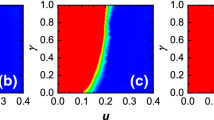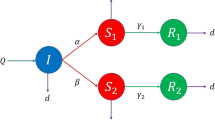Abstract
This paper considers a topology formation problem for wireless ad hoc networks. There are wireless nodes located on a plane. Each node can adjust its transmission power in the dynamic mode. The global objective lies in assigning an optimal transmission power to each node so that the resulting topology is connected and minimizes the total power cost. The topology formation problem is studied as a noncooperative game. The author proposes two algorithms of collective behavior and network formation based on the so-called “double best response” decision rule. This decision rule originates from the reflexive game framework and describes the behavior of an agent with reflexion rank 1. The efficiency of the suggested algorithms is evaluated by simulation and compared with the standard best response algorithm.
Similar content being viewed by others
References
Bazenkov, N.I., Reflexion in the Topology Control Problem of a Wireless Network, Tr. 55 Nauchn. Konf. Mosk. Fiz.-Tekh. Inst.: Radiotekh. i Kibern. (Proc. 55 Scient. Conf. of Moscow Inst. of Physics and Tech.: Radiotech. and Cybernetics), Moscow, 2012, vol. 1, pp. 46–48.
Gubko, M.V., Control of Organizational Systems with Network Interaction of Agents. I. A Review of Network Game Theory, Autom. Remote Control, 2004, vol. 65, no. 8, pp. 1276–1291.
Korepanov, V.O., Modeli refleksivnogo gruppovogo povedeniya i upravleniya (Models of Reflexive Group Behavior and Control), Moscow: Inst. Probl. Upravlen., 2011.
Korepanov, V.O. and Novikov, D.A., The Diffuse Bomb Problem, Autom. Remote Control, 2013, vol. 74, no. 5, pp. 863–874.
Novikov, D.A. and Chkhartishvili, A.G., Refleksivnye igry (Reflexive Games), Moscow: Sinteg, 2003.
Althaus, E., Cǎlinescu, G., Mǎndoiu, I.I., Prasad, S., Tchervenski, N., and Zelikovsky, A., Power Efficient Range Assignment in Ad Hoc Wireless Network, IEEE Wireless Communications and Networking Conf. (WCNC 2003), New Orleans, 2003, vol. 3, pp. 1889–1894.
Azis, A.A., Ekercioğlu, Y.A., Singh, J.P., and Venkatasubramanian, N., A Survey on Distributed Topology Control Techniques for Extending the Lifetime of Battery PoweredWireless Sensor Networks, IEEE Commun. Surv. Tutor., 2013, vol. 15, no. 1, pp. 121–144.
Calinescu, G. and Qiao, K., Asymmetric Topology Control: Exact Solutions and Fast Approximations, IEEE INFOCOM Proc., Orlando, 2012, pp. 783–791.
Clementi, A.E.F., Penna, P., and Silvestri, R., On the Power Assignment Problem in Radio Networks, Electron. Colloquium on Computational Complexity (ECCC), 2000, URL: http://eccc.hpi-web.de/ecccreports/2000/TR00-054/index.html (Cited April 5, 2013).
Do, N.M., Hsu, C.-H., Singh, J.P., and Venkatasubramanian, N., Massive Live Video Distribution Using Hybrid Cellular and Ad Hoc Networks, IEEE Int. Symp. on World of Wireless, Mobile and Multimedia Networks (WoWMoM), Lucca, Italy, 2011, pp. 1–9.
Eidenbenz, S., Kumar, A., and Zust, S., Equilibria in Topology Control Games for Ad Hoc Networks and Generalizations, Mobile Network Appl., 2006, vol. 11, no. 2, pp. 143–159.
IEEE Std. 802.11 Part 11: Wireless LAN Medium Access Control (MAC) and Physical Layer (PHY) Specifications, 2012, URL: http://standards.ieee.org/getieee802/download/802.11-2012.pdf (Cited April 5, 2013).
IEEE Std. 802.15.4 Part 15.4: Low-Rate Wireless Personal Area Networks (LR-WPAN), 2011, URL: http://standards.ieee.org/getieee802/download/802.15.4-2011.pdf (Cited April 5, 2013).
Jackson, M.O., A Survey of Models of Network Formation: Stability and Efficiency, in Group Formation in Economics: Networks, Clubs and Coalitions, Demange, G. and Wooders, M., Eds., Cambridge: Cambridge Univ. Press, 2005, pp. 11–57.
Komali, R.S., MacKenzie, A.B., and Gilles, R.P., Effect of Selfish Node Behavior on Efficient Topology Design, IEEE Trans. Mobile Computing, 2008, vol. 7, no. 9, pp. 1057–1070.
Li, N., Hou, J.C., and Sha, L., Design and Analysis of an MST-Based Topology Control Algorithm, 22 Annual Joint Conf. of the IEEE Computer and Communications (INFOCOM 2003), San Francisco, 2003, vol. 3, pp. 1702–1712.
Li, L., Halpern, J.Y., Bahl, P., Yi-Min, W., and Wattenhofer, R., A Cone-Based Distributed Topology-Control Algorithm for Wireless Multi-Hop Networks, IEEE/ACM Trans. Networking, 2005, vol. 13, no. 1, pp. 147–159.
Long, C., Zhang, Q., Li, B., Yang, H., and Guan, X., Non-Cooperative Power Control forWireless Ad Hoc Networks with Repeated Games, IEEE J. Selected Areas Commun., 2007, vol. 25, no. 6, pp. 1101–1112.
Monderer, D. and Shapley, L.S., Potential Games, Games Econom. Behav., 1996, vol. 14, pp. 124–143.
Nisan, N., Roughgarden, T., Tardos, E., and Vazirani, V.V., Algorithmic Game Theory, New York: Cambridge Univ. Press, 2007.
Santi, P., Topology Control in Wireless Ad Hoc and Sensor Networks, J. ACM Comput. Surv. (CSUR), 2005, vol. 37, no. 2, pp. 164–194.
Shi, H.-Y., Wang, W.-L., Kwok, N.-M., and Chen, S.-Y., Game Theory for Wireless Sensor Networks: A Survey, Sensors, 2012, vol. 12, no. 7, pp. 9055–9097.
Toh, C.K.-K., Ad Hoc Wireless Networks: Protocols and Systems, Upper Saddle River: Prentice Hall, 2002.
Ren, H. and Meng, M.Q.-H., Game-Theoretic Modeling of Joint Topology Control and Power Scheduling for Wireless Heterogeneous Sensor Networks, IEEE Trans. Automat. Sci. Eng., 2009, vol. 6, no. 4, pp. 610–625.
Wattenhofer, R. and Zollinger, A., XTC: A Practical Topology Control Algorithm for Ad-Hoc Networks, 18th Int. Parallel and Distributed Processing Symp., Santa Fe, 2004, pp. 216–223.
Zarifzadeh, S., Yazdani, N., and Nayyeri, A., Energy-efficient Topology Control in Wireless Ad Hoc Networks with Selfish Nodes, Computer Networks, 2012, vol. 56, pp. 902–914.
Author information
Authors and Affiliations
Corresponding author
Additional information
Original Russian Text © N.I. Bazenkov, 2013, published in Upravlenie Bol’shimi Sistemami, 2013, No. 43, pp. 217–239.
Rights and permissions
About this article
Cite this article
Bazenkov, N.I. Double best response dynamics in topology formation game for ad hoc networks. Autom Remote Control 76, 323–335 (2015). https://doi.org/10.1134/S0005117915020125
Received:
Published:
Issue Date:
DOI: https://doi.org/10.1134/S0005117915020125




